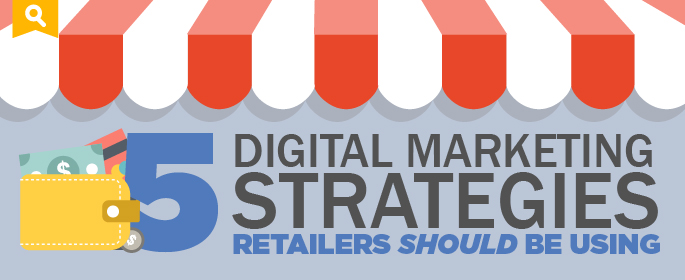
For many of us, shopping is a pastime that’s as American as baseball and apple pie. But that pastime is undergoing an evolution. The ways that we shop have changed drastically in the last decade and some retailers are suffering while others are thriving. For many, the difference centers on the ability to adapt to the rise of digital access and opportunity.
On August 16, Overit held a panel in conjunction with the Google Partners Connect: Retail event. The panel featured speakers including Teah Teriele, Death Wish Coffee Company; Max Kerber, RAD Soap, Co.; Jodie Evans, Trans World Entertainment; Ted Potrikus, Retail Council of NYS; and yours truly. It was a lively discussion on how this group of professionals is approaching innovations in branding, data and digital integration. While everyone has their own unique perspective on what works, here were some of the common themes that every retailer can use.
Gathering Data Across Channels
Between websites, social media and physical point-of-sale locations there is a lot of data at our disposal. But that data is often disparate and silo-ed. For example, are we consistently aware when someone interacted on social media, signed up for a newsletter and then purchased an item in the store? Not often enough. But the ability to identify these touchpoints and track these activities can help inform personalized outreach messaging and guide over-arching marketing strategies.
This level of insight often requires software integrations between CRMs, web and mobile analytics and POS data. While infrastructure is often slow to change, our access to customer data will only increase from this point forward and it is a transition that many retailers are making sooner rather than later.
Think Mobile First
If you’ve been out in public recently, you’ve probably noticed how frequently those around you are staring at their phones. Just for fun, try walking through a mall or even a Target, and just observe how frequently you see people on their phones.
Are they texting home to make sure they didn’t forget anything on the shopping list? Are they using a shopping app? Reading reviews? Comparing prices for an item in front of them to one online? Are they posting on social media about what they are doing?
It could be any one of those things – or any one of dozens of other possibilities. The one thing that is for certain is that slowly but surely mobile traffic has begun to eclipse desktop traffic for most sites. That makes mobile responsiveness and mobile purchasing experiences paramount for every retailer’s marketing plan. Additionally, this may include the development of branded apps and the ability to accommodate the use of popular apps like Smart Wallets. This also means having a presence on other highly used mobile applications. It just so happens that some of the most frequently used mobile apps belong to popular social media sites like Facebook, Instagram and Twitter. This also supports the cultivation of an engaging presence on these platforms.
Proximity Marketing Can Hit Close To Home
The rise of mobile technology demands not only a positive mobile user experience, but it also offers opportunities. One of the most promising is the ability to use proximity marketing to fine tune marketing and product presentation in new and exciting ways. Proximity marketing is a trend that utilizes mobile devices, Wi-Fi, and RFID technology to help retailers connect directly with customers.
Mobile technology gives us unprecedented influence and insight in customer behaviors. For internal studies, a business can implement beacons to observe in-store foot-traffic patterns. Other stores are effectively issuing push notifications to draw customers in the direct vicinity by alerting them to a daily deal or seasonal promotion. Sure, mobile has created new challenges in serving customers, but it balances those by giving us immediate customer access and feedback. Proximity marketing and, the responses each initiative brings, can impact the way we do everything from email timing to arranging displays.
Create a Brand Experience
With so many buying options, our capacity to connect and attract customers has become even more deeply rooted in identity. Not just our ability to tap into a consumer’s individual identity but the appeal of the brand’s identity. For brick and mortar stores, when a customer enters your store it’s essential that there be a consistent and conscientious effort to involve all 5 senses. Digital and mobile enterprises have distinct advantages in terms of access and convenience that a physical store may never be able to match.
However, a store can offer an immersive experience that is difficult to replicate online. With that said, even an online only business should be aware of how users experience their brand across channels, from a website to social media profiles to presentation and messaging in an Amazon storefront. A brand’s imagery and voice should always reflect the brand’s messaging consistently.
Use Search Influence Everywhere
Organic search is a major driver of traffic for most websites, but search insight goes far beyond how much traffic we’re getting from Google. Search data can be used to evaluate competitors and help influence new content development. Content that is built based on what people are searching for has an opportunity to rank, but moreover it directly addresses topics that are of popular interest. This allows a brand to speak to use an educated standpoint to provide information that people are seeking.
But additional avenues of search also provide opportunities to learn and reach customers. Internal site search helps us evaluate what people are looking for from a specific brand. This can guide new product decisions or influence the way existing products and content are presented.
Also, searches are being conducted every day in social media and Amazon. Facebook profiles, Twitter and Instagram content and even Amazon storefronts can be optimized to help users find what you’re posting. As with all of SEO, there’s a need for balance between messaging and keyword uses, but keyword research has a place in profile creation for more than just Google.
The blend of insights from those on the panel offered multiple perspectives on the transformation of retail as we know it. While there were many overlapping themes, one constant among those present was the resounding importance of passion. Yes, buyers become passionate about the brand they love and that fosters loyalty. But as brands, you must continue to be passionate about what you’re doing. From celebrating a rich history of tradition to embarking on new adventures with technology. In order to flourish, not just survive, a retailer can embrace changes in data, mobile and search while still making the heart of the brand the beating center of their success.
[Unable to attend the panel discussion? You can watch it all right here!]







